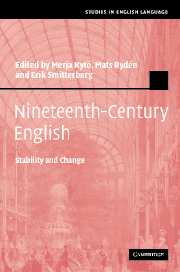Book contents
- Frontmatter
- Contents
- List of plates
- List of figures
- List of tables
- List of contributors
- Acknowledgements
- Introduction: Exploring nineteenth-century English – past and present perspectives
- 1 Modifiers describing women and men in nineteenth-century English
- 2 Words in English Record Office documents of the early 1800s
- 3 The subjunctive in adverbial clauses in nineteenth-century English
- 4 The passive in nineteenth-century scientific writing
- 5 Relativizers in nineteenth-century English
- 6 Anaphoric reference in the nineteenth century: that/those + of constructions
- 7 Adjective comparison in nineteenth-century English
- 8 Nonfinite complement clauses in the nineteenth century: the case of remember
- 9 The in -ing construction in British English, 1800–2000
- 10 Partitive constructions in nineteenth-century English
- Appendix
- References
- Name index
- Subject index
9 - The in -ing construction in British English, 1800–2000
Published online by Cambridge University Press: 22 September 2009
- Frontmatter
- Contents
- List of plates
- List of figures
- List of tables
- List of contributors
- Acknowledgements
- Introduction: Exploring nineteenth-century English – past and present perspectives
- 1 Modifiers describing women and men in nineteenth-century English
- 2 Words in English Record Office documents of the early 1800s
- 3 The subjunctive in adverbial clauses in nineteenth-century English
- 4 The passive in nineteenth-century scientific writing
- 5 Relativizers in nineteenth-century English
- 6 Anaphoric reference in the nineteenth century: that/those + of constructions
- 7 Adjective comparison in nineteenth-century English
- 8 Nonfinite complement clauses in the nineteenth century: the case of remember
- 9 The in -ing construction in British English, 1800–2000
- 10 Partitive constructions in nineteenth-century English
- Appendix
- References
- Name index
- Subject index
Summary
Defining in -ing complements
In recent years there has been a renewal of interest in issues of complementation, generated in large part by the increasing availability of new electronic corpora. Some of this work has had a purely synchronic focus on Present-day English, but there has also been renewed attention paid to diachronic aspects of the system of English predicate complementation, and how it has developed over time (see also Mair, this volume). The present article offers a contribution to the latter area of research and takes up a particular aspect of verb complementation in the nineteenth and twentieth centuries on the basis of corpus evidence, in order to investigate stability and change in this part of English grammar.
Consider sentence (1), taken from the Bank of English Corpus:
(1) The Titans delight in upsetting the odds, […]
(Times/UK)The pattern of sentence (1) essentially involves the preposition in and a following -ing clause. (The term ‘clause’ is used here to refer to a subordinate sentence.) Adopting the label first introduced in Rudanko (1991) and also used for instance in Francis et al. (1996: 194–5), the pattern may be called a type of the in -ing pattern. The particular in -ing pattern in question is the one where the pattern is associated with a matrix verb, as with delight in sentence (1).
There are a number of properties of the in -ing pattern as illustrated in sentence (1) that should be emphasized here.
- Type
- Chapter
- Information
- Nineteenth-Century EnglishStability and Change, pp. 229 - 241Publisher: Cambridge University PressPrint publication year: 2006
- 1
- Cited by



